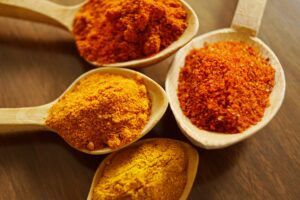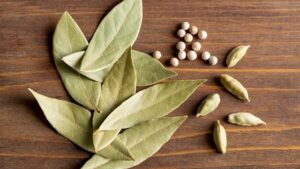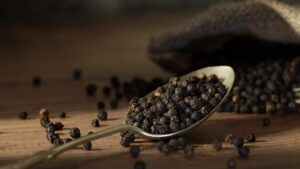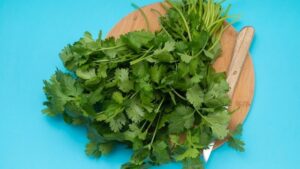Turmeric is a bright yellow spice derived from the roots of the Curcuma longa plant, a member of the ginger family. It is widely known for its culinary uses, vibrant color, and various potential health benefits.
In the realm of spices, turmeric stands out not just for its vibrant color but also for its incredible versatility and numerous health-promoting properties. From ancient traditions to modern kitchens, this golden-hued spice has held a prominent place, enriching cuisines and captivating cultures worldwide.

Characteristics of Turmeric
Turmeric possesses several distinctive characteristics that contribute to its culinary, medicinal, and cultural significance:
Vibrant Color
- Golden-Yellow Hue: The spice exhibits a vibrant and intense golden-yellow color, which is attributed to its active compound, curcumin. This vivid hue adds brightness to dishes and makes turmeric easily recognizable.
Flavor Profile
- Earthy and Warm: Turmeric offers an earthy flavor profile with subtle bitterness, complemented by warm and peppery undertones. Its taste is slightly aromatic, resembling a blend of ginger and orange zest.
Texture and Form
- Powdered Spice: As a commonly used form, turmeric is available as a fine powder obtained by drying and grinding the rhizomes (roots) of the Curcuma longa plant. This powdered spice is convenient for cooking and easy incorporation into various recipes.
Active Compound: Curcumin
- Health-Promoting Agent: The presence of curcumin, a bioactive compound in turmeric, contributes to its potential health benefits. Curcumin is known for its antioxidant and anti-inflammatory properties, believed to support overall well-being.
Staining Properties
- Intense Coloring: The bright yellow pigment in turmeric is potent and can easily stain surfaces, fabrics, and kitchen utensils. It is advisable to handle turmeric powder carefully to prevent staining.
Aroma
- Subtle Aromatic Notes: While not as fragrant as some other spices, turmeric emits a mild, earthy aroma when used in cooking or as a raw ingredient.
Culinary Versatility
- Culinary Applications: Turmeric is a versatile spice used in a wide array of dishes, from savory curries, rice dishes, and soups to marinades, sauces, and beverages. It’s a key component in spice blends such as curry powder.
Cultural and Traditional Importance
- Cultural Symbolism: Turmeric holds cultural significance in various traditions, ceremonies, and rituals in different cultures, symbolizing purity, prosperity, and well-being.
Conclusion
Turmeric’s vibrant color, distinct flavor profile, health-promoting compounds, and cultural significance contribute to its widespread use in cuisines, health practices, and traditional rituals globally. This versatile spice continues to enchant with its rich hue and potential benefits, making it an essential ingredient in diverse culinary and cultural landscapes.
Culinary Uses
Turmeric, with its vibrant color and distinct flavor, serves as a versatile spice in various culinary applications. Here’s a detailed look at its diverse uses in cooking:
Flavor Profile and Culinary Characteristics
- Earthy Flavor: Turmeric offers an earthy taste with subtle bitterness and warm, peppery undertones, contributing depth to dishes.
- Golden Color: Its vivid yellow color not only brightens dishes but also adds an appealing visual element to culinary creations.
Culinary Applications
Curries and Stews
- Key Ingredient in Curries: Turmeric is a fundamental component in curry preparations, imparting color and flavor to dishes. It’s often combined with other spices for aromatic and savory curries.
- Stews and Braises: Used to enhance the flavor profile of meat, vegetable stews, and braised dishes, infusing them with its distinctive taste.
Rice and Grains
- Rice Dishes: Adds color and flavor to rice preparations, including pilafs, biryanis, and fried rice, giving them a vibrant golden hue.
- Grains: Incorporated into dishes like quinoa, couscous, and lentils for both flavor and color enhancement.
Vegetables and Roasted Dishes
- Roasted Vegetables: Sprinkled on roasted vegetables or used in marinades, enhancing their taste while adding a golden glaze.
- Seasoning for Vegetables: Adds depth to sautéed or stir-fried vegetables, boosting their flavor profile.
Soups and Broths
- Soup Base: Used as a spice in soups and broths, giving them a warm, earthy flavor and enhancing their appearance.
Beverages
- Golden Milk: Included in “golden milk” or turmeric latte, a popular beverage made by combining turmeric with milk or plant-based milk and other spices for a comforting drink.
- Teas and Infusions: Used in herbal teas and infusions for both its flavor and potential health benefits.
Cooking Tips
- Use Sparingly: Turmeric has a strong pigment and flavor, so start with small amounts and adjust according to taste.
- Pairing: Complements well with spices like cumin, coriander, ginger, and cinnamon, enhancing their flavors when used together.
Global Influence
- Integral to Various Cuisines: Widely used in Indian, Southeast Asian, Middle Eastern, and some African cuisines, where it plays a crucial role in traditional recipes and spice blends.
Medicinal and Health Benefits
Turmeric, renowned for its potential health benefits, is attributed to its active compound curcumin. Here’s an in-depth exploration of its various medicinal and health-promoting properties:
Anti-inflammatory and Antioxidant Effects
- Curcumin’s Role: Curcumin, the primary bioactive compound in turmeric, exhibits potent anti-inflammatory and antioxidant properties.
- Reduced Inflammation: It may help reduce inflammation in the body, potentially benefiting conditions linked to chronic inflammation.
Digestive Health
- Aids Digestion: Turmeric has been traditionally used to support digestive health. It may stimulate bile production, aid in digestion, and alleviate symptoms of indigestion.
Potential for Joint Health
- Supports Joint Function: Some studies suggest that turmeric might support joint health and flexibility, potentially aiding those with joint discomfort.
Antimicrobial Properties
- Natural Antimicrobial Agent: Turmeric exhibits antimicrobial properties, potentially assisting in combating certain types of harmful bacteria and fungi.
Heart Health
- Cardiovascular Benefits: Some research suggests that curcumin might contribute to heart health by supporting healthy cholesterol levels and promoting overall cardiovascular well-being.
Cognitive Health
- Brain Health Support: Curcumin’s antioxidant and anti-inflammatory properties are being studied for their potential role in supporting brain health and cognitive function.
Potential Cancer-Fighting Properties
- Anticancer Effects: While more research is needed, some studies suggest that curcumin may possess properties that inhibit the growth of certain cancer cells. However, this area requires further investigation.
Skin Health and Wound Healing
- Skin Benefits: Turmeric’s anti-inflammatory and antimicrobial properties might aid in managing certain skin conditions and supporting wound healing.
Usage and Caution
- Dosage Considerations: Consuming turmeric in moderate culinary amounts is generally safe. However, concentrated supplements or extracts should be used cautiously, especially for those on medications or with certain health conditions.
- Bioavailability: Curcumin’s bioavailability is low, but combining it with black pepper (piperine) or healthy fats may enhance absorption.
Traditional and Cultural Significance
Turmeric holds deep-rooted traditional and cultural significance across various societies, spanning centuries of rituals, traditions, and practices. Its importance transcends culinary and medicinal realms, symbolizing purity, prosperity, and spiritual significance. Here’s an exploration of its traditional and cultural significance:
Ayurvedic Medicine and Traditional Healing
- Ancient Healing Practices: Turmeric has been a cornerstone in Ayurvedic medicine for over 4,000 years, valued for its holistic healing properties.
- Herbal Remedies: It was used in Ayurveda to address various health concerns, ranging from digestive issues to skin conditions, due to its potential health benefits.
Cultural and Religious Practices
- Symbolism of Purity: In Hinduism, turmeric symbolizes purity, fertility, and spiritual purity. It’s used in religious ceremonies, including weddings and other auspicious occasions.
- Ceremonial Application: Turmeric paste is applied to the skin in traditional ceremonies, such as haldi ceremonies in Indian weddings, signifying blessings and good fortune.
Folklore and Beliefs
- Folk Remedies: In many cultures, turmeric was considered a remedy for various ailments and believed to possess protective qualities.
- Home Remedies: It was used in traditional home remedies passed down through generations for its potential health benefits.
Traditional Cuisine
- Integral Spice: In culinary traditions across South Asia, Southeast Asia, and the Middle East, turmeric is a fundamental spice used in curries, rice dishes, and spice blends like curry powder and masalas.
- Culinary Heritage: Its distinct flavor and vibrant color have made it an essential ingredient in traditional dishes, preserving cultural culinary heritage.
Textiles and Dyes
- Dyeing Agent: Turmeric’s rich yellow pigment was historically used as a natural dye for fabrics and textiles in various cultures, adding color to garments and textiles.
Festivals and Celebrations
- Cultural Festivities: Turmeric plays a role in festivals and cultural celebrations, symbolizing joy, abundance, and well-being.
- Symbol of Prosperity: In some cultures, offering turmeric signifies wishes for prosperity, health, and happiness.
Commercial Availability
Turmeric, with its popularity and versatile uses, is readily available in various forms, making it easily accessible to consumers globally. Here’s an overview of its commercial availability:
Forms of Turmeric
- Whole Turmeric Roots: Fresh turmeric roots are available in some markets and specialty stores, especially in regions where it’s cultivated. They can be used by grating or slicing for culinary or medicinal purposes.
- Turmeric Powder: The most common form, turmeric powder, is obtained by drying and grinding the rhizomes. It is widely available in supermarkets, grocery stores, and online retailers. Powdered turmeric is convenient for cooking and incorporation into diverse recipes.
- Capsules and Supplements: Turmeric is also available in the form of dietary supplements, capsules, or extracts. These concentrated forms often contain higher concentrations of curcumin and are used for potential health benefits. They are commonly found in health stores and pharmacies.
Commercial Availability
- Supermarkets and Grocery Stores: Powdered turmeric is a staple spice available in the spice aisle of most supermarkets and grocery stores. It’s widely accessible and affordable for consumers.
- Specialty Stores: Specialty spice shops and health food stores often offer a wider range of turmeric products, including organic options, whole roots, blends, and specialized formulations.
- Online Retailers: Various online platforms and e-commerce websites provide easy access to turmeric products. Consumers can purchase turmeric powder, supplements, and other related products from online retailers.
Packaging and Varieties
- Packaged Products: Turmeric powder usually comes in different sizes, ranging from small packets to larger containers or jars, catering to various consumer needs.
- Organic and Fair Trade Varieties: Some brands offer organic or fair trade-certified turmeric, appealing to consumers seeking sustainably sourced or high-quality products.
Global Availability
- Worldwide Accessibility: Turmeric’s popularity has made it a globally accessible spice, available in almost every country due to its widespread culinary and health-related usage.
Conclusion
Turmeric, in its various forms, enjoys broad commercial availability across different retail channels, catering to diverse consumer preferences and culinary needs. Its widespread accessibility in supermarkets, specialty stores, and online platforms ensures its availability to consumers worldwide, allowing people to harness its culinary and potential health benefits with ease.




